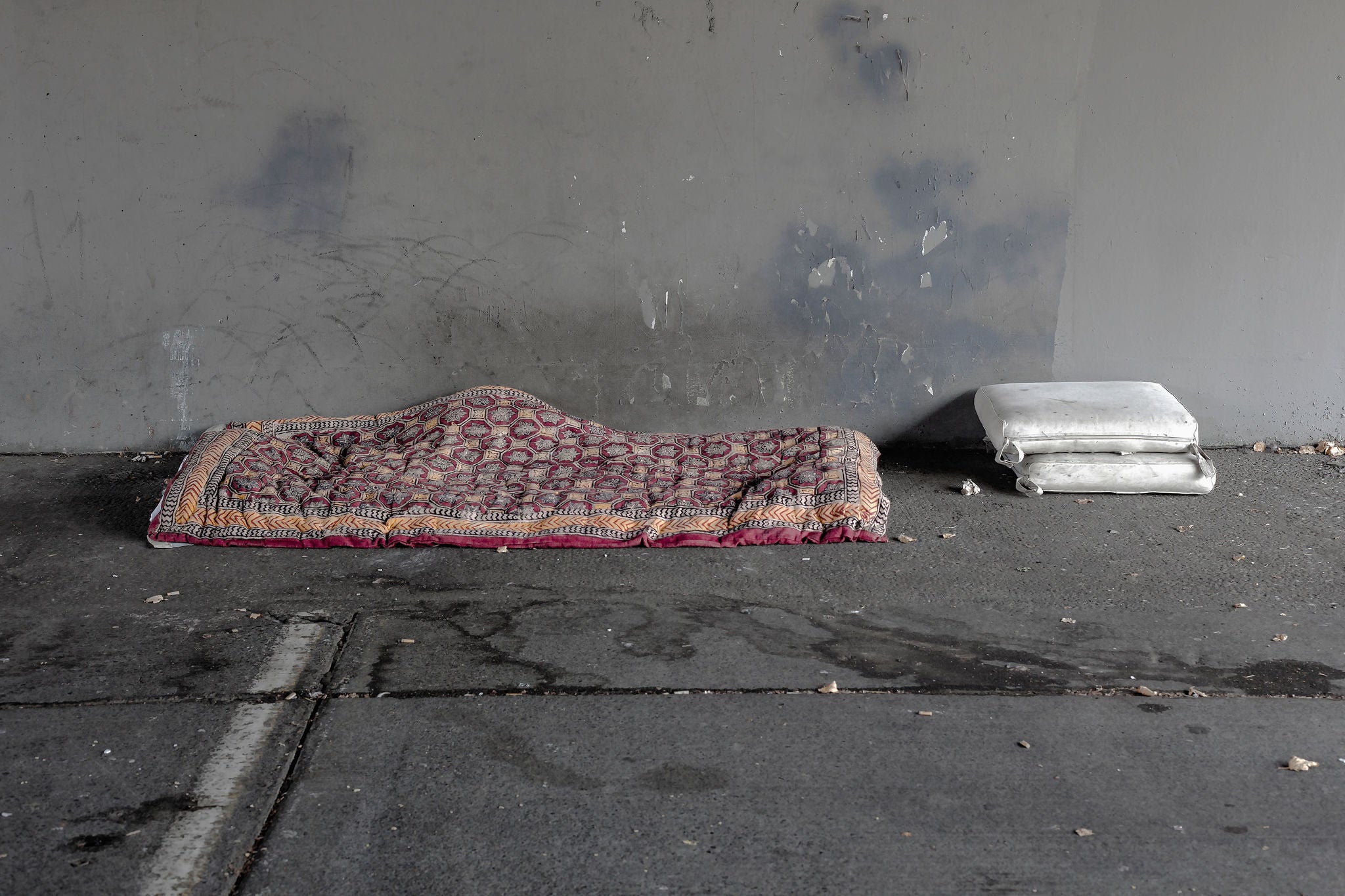EY refers to the global organization, and may refer to one or more, of the member firms of Ernst & Young Global Limited, each of which is a separate legal entity. Ernst & Young Global Limited, a UK company limited by guarantee, does not provide services to clients.

How can data stop homelessness before it starts?
A new, data-centric approach could help governments move from reacting to homelessness to actively preventing it.
In brief
- Even before the COVID-19 pandemic and the current economic uncertainty, nations struggled to confront homelessness — and assumed it might be with us forever.
- Maidstone Borough Council (UK) has shown that better use of existing data and resources, along with predictive modeling and analytics, can drive prevention.
- Using technology to create a smart safety net has the potential to transform how governments deliver social care.
Homelessness has long been a challenge of epidemic proportions throughout the world, even before it was exacerbated by the COVID-19 pandemic. Many countries have instituted programs to address this seemingly intractable problem, but few (if any) have made it the priority it should be. We know — from both research and experience — that adequate housing plays a key role in broadly improving individual health and wellbeing, while also contributing to meaningful social progress.
In addition to having serious moral and economic dimensions, homelessness is a public health issue. It’s essential to point out that housing is one of the primary components of the Social Determinants of Health (SDOH). And with this, many subject matter experts (SMEs) maintain that adequate housing is the most important of those factors, since it’s difficult for the homeless to access any of the other myriad of health services they might need. Advocates and SMEs often use this phrase “Housing is healthcare,” — at EY, we agree.
There are many complex reasons that sustainable solutions to homelessness continue to elude both developing and developed nations, from inadequate use or sharing of existing data and insufficient or poorly utilized resources, to a lack of understanding about how big the impact could be if the persistent problem were resolved. Perhaps most troublesome is that, too often, the approaches taken by governments and agencies are built on a flawed premise, i.e., that homelessness is a foregone conclusion. It’s a given that there are no easy answers.
However, now more than ever before, human services organizations have the opportunity to rethink how they address their homelessness challenge. We see technology disrupting and transforming other sectors all around us. What if technology could be applied to help agencies move beyond the “treat-the-wound” crisis mode in which most nations now find themselves? Could they utilize a more hopeful, sustainable and strategic approach, that’s focused sharply on early intervention and prevention?
Chapter 1
Heading in the wrong direction
The global homelessness challenge is growing. Governments need to change their approach.
Homelessness is a reality in virtually every country, regardless of the type of government or the economic, social or cultural backgrounds of its population. The last time the United Nations conducted a global survey, in 2005, it estimated 100 million people had no home at all. More recently, in 2015, experts estimated that number exceeded 150 million worldwide, with an additional 1.6 billion living in inadequate housing and 15 million forcibly evicted every year.
The real numbers are almost certainly far higher. It has always been very difficult to accurately count people who don’t have a reliable address at which to find them, and the social and economic impact of the COVID-19 pandemic will inevitably have led to an increase in homeless cases. Furthermore, there’s no standard definition of what “homeless” means. Governments often downplay the problem’s prevalence and impact, and many homeless people are reluctant to come forward and be registered if given the opportunity.1
Estimated homeless numbers around the world
- The United States reported almost 570,000 homeless people; England counted about 280,000; and Germany, France, Canada, Australia and Brazil each had more than 100,000, according to the most-recent surveys in each country.
- China and India, the world’s most-populous nations, reported having 3 million and 1.77 million homeless, respectively; those are rates of 0.22% and 0.14%, which are on a statistical par with many more-developed countries.
- Accurate numbers have been difficult to ascertain in Africa (as they are elsewhere), but Kenya has reported that its homeless population stands at more than 20,000 and the count is about 200,000 in South Africa.
Governments and human services agencies need to do more to address the long list of social challenges that cause or contribute to homelessness: poverty and unemployment; family breakdowns; inadequate services and facilities for people suffering from mental illness, alcoholism or substance abuse; and more.
It is clear that many governments around the world are seeking to reduce their levels of homelessness but approaches vary significantly. Last year, The Organisation for Economic Co-operation and Development issued a report summarizing the findings of its Questionnaire on Affordable and Social Housing in 2016, 2019 and 2021. Of the 45 countries that responded, 21 reported having active national homelessness strategies and seven reported having regional or local strategies. Disappointingly, 18 countries reported they had not implemented any strategies to confront homelessness.
Examples of homelessness strategies
Australia
The 2020 Homelessness Strategy in the State of Victoria commits AU$340 million to help about 350,000 people with efforts including the Opening Doors coordination project; new Indigenous family violence facilities; assistance for women and children experiencing family violence to remain in their homes; the flagship Common Ground supportive housing project in inner Melbourne; and the provision of more stable accommodations in outer metropolitan areas and regional Victoria for homeless families and individuals under the A Place to Call Home initiative.
Canada
Reaching Home is a community-based initiative that provides direct financial aid to specific urban communities, as well as Indigenous, rural and remote communities, to support innovative efforts to combat homelessness. Communities determine their own needs and priorities. Reaching Home began in 2019, supporting the goals of Canada’s first-ever, 10-year, CA$55 billion National Housing Strategy. Reaching Home aims to maintain safe, stable and affordable housing for the most-vulnerable people and to reduce chronic homelessness nationally by 50% by 2027–28.
Chile
Policies in South American countries have tended to move toward dealing with homelessness through government subsidies. In Chile, the Ministry of Housing and Urban Development in 2014 initiated its first rental-subsidy program to assist low- and middle-income populations. The program consists of a flat-rate, time-limited subsidy that provides some degree of administrative simplicity and payment flexibility for people with incomes that are low and/or volatile. The basic objective is to facilitate an average contribution of 25% of a family’s monthly income toward their rent.
Denmark
The government allocated DKK154 million (about €20.5 million) for 10 separate initiatives in its 2018–2021 Action Plan Against Homelessness. Among other objectives, the initiatives contributed to existing programs to help the homeless, as well as new ones aimed at young people in particular. Much of the funding also was targeted toward supporting local authorities for investments in comprehensive social services aiming to prevent homelessness. In addition, some of the money was designated for the creation of national guidelines on the subject of combating homelessness.
England
The Homelessness Prevention Grant will provide £315.8 million in 2022–23 to support local authorities in delivering services to prevent and address homelessness. It follows an investment of £310 million granted 2021–2022. The government’s new grant is intended to support people in England who are homeless or are at risk of losing their homes. Local authorities are to use the money to help constituents who need to find a new home, to access support after unexpected evictions and/or to secure temporary housing when needed.
France
In 2018, France launched its Five-year Plan to Implement Housing First and Combat Homelessness, which contains five priorities: produce and mobilize more affordable housing adapted to the needs of the homeless and people with poor housing; promote and accelerate access to housing and facilitate residential mobility for disadvantaged populations; better-support homeless populations and help them stay sheltered; prevent interruptions in housing and ensure that emergency shelters provide immediate support; and mobilize territorial stakeholders to put Housing First principles into place.
US
In an economic relief package passed in March of 2020, the US Congress appropriated an additional US$4b to the Emergency Solutions Grants (ESG) program, already set at US$290m. The ESG program provides grants to cities and states to operate temporary emergency shelters and provide Rapid Re-Housing (RRH) vouchers; a short- to medium-term rental assistance program that gives subsidies to people experiencing homelessness so they can rent units in the private market. ESG is an existing element of the federal government's homeless assistance system.
While it’s heartening that many countries are taking a variety of steps to reduce the impact of homelessness, it’s also clear that the trend lines are still headed in the wrong direction. So, we believe a couple of additional questions need to be asked:
- Are governments, agencies and non-governmental organizations (NGO) expending their money and other resources with a long-term vision, or focusing on tactics to make it through another day?
- Are they effectively utilizing existing data and technologies to form a comprehensive view that will enable them to get ahead of the problem?
Chapter 2
Progressing from reaction to prevention
Governments can employ data and analytics to address homelessness before it starts.
Governments, agencies, NGOs and related entities routinely amass enormous stores of data covering a broad range of medical and social services. The problem is that, far too often, the data is siloed within and across programs and sectors. This is the case even though there’s broad consensus that the routine sharing of relevant information would enhance care coordination, lower costs and, most importantly, improve outcomes.
It’s therefore essential to enable the differing systems of the many organizations to securely exchange their data. The good news is that interoperability and data-sharing projects are already in place in many countries, most of them focused on healthcare and related sectors. Now it’s time for those efforts to prioritize sharing information that can be used to help the homeless.
To meaningfully assist someone to get to a better place, governments must identify the specific factors that caused an individual or family to become homeless, and then address those issues with comprehensive, person-centered health and social services. Data, specifically the powerful insights it provides, can make this seemingly impossible task possible. Most pointedly, governments can learn from the data not only what works to address and remediate homelessness, but also how to avert it.
How data analytics reduced homelessness by 40%
When homelessness in Maidstone, England, soared by 58% over just five years, the Borough Council sought to shift its focus from crisis response to building early-intervention and prevention capacity. Working with EY teams and our UK technology partner, Xantura, the council created and implemented a data-focused tool — called OneView — that enabled the council to tackle their challenges in a new way.
Specifically, OneView’s predictive analytic and natural language generation capabilities enabled participating agencies in Maidstone to bring together their data to identify residents who were at risk of homelessness, and then to intervene before they were actually living on the street. In the initial pilot year, almost 100 households were prevented from becoming homeless, even as the COVID-19 pandemic took hold and grew. And, overall, the rate of homelessness fell by 40%.
This pioneering effort instigated other significant benefits, too:
- Generated about £2.5 million in broader societal savings and produced a 192% return on investment for the town, with the potential for that to increase to 660% with the broader rollout of the initiative.
- Reduced the time spent on administrative tasks by 61 days, enabling front-line workers to devote more of their efforts to directly assisting individuals who required services — and it was estimated that the number could rise to 160 days after the broader rollout.
- Consolidated more than 15 different data files, providing a far-more-holistic understanding of vulnerable individuals while furthering interagency collaboration.
While the work on this initiative demonstrated what’s possible, it’s important to acknowledge that one size will not fit all. To assess how they can get ahead of their own homelessness problems, governments need to address an array of challenges — some very specific to their individual circumstances and others broadly faced by many, if not most, jurisdictions.
There are, however, a number of key action items that can help organizations as they embark on their analytics journey. An EY report called Harnessing the power of data: can reality catch up with ambition, produced in collaboration with Imperial College London’s Institute of Global Health Innovation, outlines six recommendations:
- Align purpose, strategy and leadership.
- Create the business case for adequate funding.
- Build public confidence in the use of data.
- Create robust data quality and governance frameworks.
- Support staff adoption and buy-in.
- Encourage continual innovation to embed change.
Chapter 3
A vision and a roadmap for transformation
Building a smart safety net that addresses the complexity of social care.
As evidenced by the Maidstone model, data analytics and predictive modeling will play an indispensable role in enabling us to realize a very big vision — a world in which everyone has a reliable roof over their heads.
Against that backdrop, it’s important to stress that the roadmap for preventing homelessness has to contain components beyond just better avenues for using data. It must also include shrewd approaches for dealing with complex issues such as funding, standards, governance, cultural differences and informed consent to permit the exchange of personal information, among others. Perhaps most importantly, the work needs to be championed by organizational and governmental leaders who believe transformative, systemic change is possible and are committed to achieving it.
Introducing the Smart Safety Net
To move forward, human services organizations need to look beyond modernizing service delivery to transforming it, and to evolve from integration to intuitive design. New technologies provide opportunities to truly rethink and redesign in ways that would have been impossible in the past.
A Smart Safety Net can shape a bold new future for social care. Doing so will require broad, fundamental changes at an organizational level, more collaboration across agencies, data integration and greater care co-ordination. At its heart, a Smart Safety Net entails:
- A system-wide approach to addressing the needs of each individual and family, including pooled funding that supports coordination so that, for example, users in one program are automatically enrolled in other programs for which they are eligible.
- Human-centered design that genuinely integrates the recipients of services (patients, clients, customers, etc.), as well as their experiences and insights, into the creation and implementation of policies, systems and services that affect them.
- Data-driven policy, services, workflows, automation and security to improve processes, save money and facilitate accurate, real-time decision-making, especially to advance the overarching priority of nearly every program and service; that is, early intervention and prevention.
- Frontline case workers who are supported and empowered to focus on their core purpose. With a lower administrative burden, they are able to invest more time in building relationships with vulnerable constituents and act as “coaches” to improve people’s lives.
- Outcomes-based commissioning of services, measured against a more holistic wellbeing framework, from an ecosystem of public, private and not-for-profit providers, with government acting as system stewards and service integrators.
Conclusion
Rarely in human services will you hear the phrase “money is not the primary issue.” But eradicating homelessness will require much more than additional funding. This problem existed long before the pandemic and will likely continue to exist long into the future. To the extent that emergency funds are available, they certainly are sorely needed. At the same time, digital tools and knowledge resources can provide governments — especially at the local level — with tailored solutions that help to remove obstacles relating to technology, third-party vendors and application processes.
Most pointedly, in our view, skeptics who say there is no answer to homelessness are missing something. The key is in integrating the abundant amount of data held on systems across agencies and how to best use the insights to enable early intervention. Government, with its place at the head of the table, has the opportunity to know more and do more than the innumerable private organizations, online groups and nonprofits that are working to end homelessness.
Effectively sharing information across systems and agencies can provide invaluable insights into specific needs and potential solutions. Determining how best to meet those needs, whether for an individual or a family, requires governments to know what relevant information is available and then enable its sharing with service providers and others who can genuinely help. Both of these advances, knowing the real need and knowing the data, will accelerate our ability to reach every society’s ultimate goal: connecting people with the resources they need to prevent them from ever sliding into homelessness.
Summary
Technology provides human services agencies with a significant opportunity to rethink and transform how services are delivered to the most vulnerable residents in their care. Predictive modeling has the power to enable early interventions that prevent individuals and families from reaching crisis point.
How EY can help
-
Our Government & Public Sector teams help governments transform their digital approach to improve citizens’ experiences. Learn more.
Read more -
Our team of human services professionals can help your business achieve improved service delivery and better outcomes for the vulnerable. Find out more.
Read more




